AJKOER
Radically Dubious
    
Posts: 3026
Registered: 7-5-2011
Member Is Offline
Mood: No Mood
|
|
Magnetizer and Chemical Reactions - Experiment
The topic is testing the effects of low level magnet fields on chemical reactions. For the first experiment, I place a magnetizer in one of two
identical mixtures of H2O (tap water with oxygen)/Fe filings/dissolved CO2/and a bit of sea salt.
In 7 hours, the Magnetizer disk was clear, but the other noticeably cloudy (reddish). Two hours later the Magnetizer disk was almost the same color
(see picture).
I removed the Magnetizer, which showed a wet blackish salt (See picture). This salt soon turned reddish on drying.
My explanation of the lack of reaction for 7 hours is that the weak magnetic field impacted the dissociation of H2CO3, or the solubility of CO2 (see
A. Pazur and M. Winklhofer, Magnetic effect on CO2 solubility in seawater: A possible link between geomagnetic field variations and climate, Geophys.
Research Letters, 35 (2008) L167. Link: http://onlinelibrary.wiley.com/doi/10.1029/2008GL034288/full
In time, this was apparently reversed and CO2 left the solution allowing the introduction of dissolved O2 and formation of Fe2O3.xH2O.
The picture of the salt on the Magnetizer similarly shows a damping of the iron oxidation.
In a recent thread concerning HOCl breakdown in swimmings pools, there was a reference to a proposed use of commercial strength magnetizer (this may
be an alternating magnetic field as distinct from static) that claimed less free chlorine was needed (as would occur with a reduced dissociation of
HOCl into the weaker hypochlorite). Link: http://www.sciencemadness.org/talk/viewthread.php?tid=76804#...
Some general background material, see 'Magnetic and Electric Effects on Water' by Martin Chapman at http://www1.lsbu.ac.uk/water/magnetic_electric_effects.html
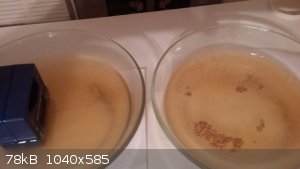 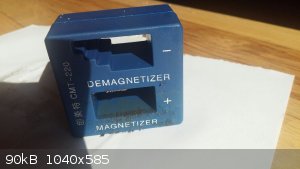
[Edited on 1-10-2017 by AJKOER]
|
|
|
AJKOER
Radically Dubious
    
Posts: 3026
Registered: 7-5-2011
Member Is Offline
Mood: No Mood
|
|
Experiment 2
Repeat based on a mixture of boiled tap water/ some vinegar/ bit of sea salt. Near equal amounts of iron filings added to half the volume of the
prepared solution. One solution has a Magnetizer inserted into it. Picture taken some 15 hours latter.
It appears that the Magnetizer solution has a different viscosity and a taint darker color.
The reaction with atmospheric oxygen appears to be occurring a little more rapidly in the presence of the weak magnetic field. This is in accord with
the reference material provided in the opening thread with regard to the an apparent increase rate of oxygen dissolution. To quote from the Martin
Chapman reference:
"Surprisingly, even very small magnetic fields may affect the solubility of gases in seawater (solubility increasing with the magnetic field (20-50
µT) [1492], probably by their effect on the clathrate stability. This reinforces the view that it is the movement through a magnetic field, and it
associated electromagnetic effect, that is important for disrupting the hydrogen bonding. Such fields can also increase the evaporation rate of water
and the dissolution rate of oxygen (due to its paramagnetic nature) but cannot, despite claims by certain expensive water preparations, increase the
equilibrium amount of oxygen dissolved in water above its established, and rather low, equilibrium concentration [176]. Magnetic fields can also
increase proton spin relaxation [623], which may speed up some reactions dependent on proton transfer. "
Note, there was no stirring or any other agitation of the respective solutions. To be fair, I will point out that the presence of the Magnetizer
together with a small amount of attached Fe particles thereto does provide possibly more opportunity for some iron related surface chemistry (in a
weak magnetic field) with respect to the control solution.
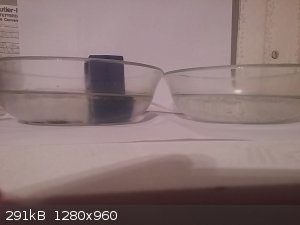
[Edited on 2-10-2017 by AJKOER]
|
|
|
MrHomeScientist
International Hazard
    
Posts: 1806
Registered: 24-10-2010
Location: Flerovium
Member Is Offline
Mood: No Mood
|
|
Glad to see you experimenting! You really need to be measuring things, though. As it is, this is only qualitative and difficult to draw conclusions
from.
"Some vinegar" and "bit of sea salt" isn't descriptive enough for someone else (or yourself) to repeat your experiment, which I'm sure you know is an
important part of doing science. "Near equal amounts of iron filings" also isn't accurate enough to see a difference, since if there is an effect here
it is likely to be very small. Thus the importance of measurement and accurate scales.
Your results are also qualitative, with no reported measurement (just a subjective description of color). If you measure your initial reactants, run
the experiment for a set period of time, then measure your results (filter and weigh the precipitated rust), it makes for a much more convincing and
repeatable experiment. You'd also want to place the magnet outside the solution, to ensure it is only the magnetic field having an effect. Put the
dish on top of the magnet instead.
|
|
|
AJKOER
Radically Dubious
    
Posts: 3026
Registered: 7-5-2011
Member Is Offline
Mood: No Mood
|
|
The reactions involving the oxidation of iron with O2 in acid is a spontaneous electrochemical reaction, so I believe take measurements if you want to
repeat experiment yourself, but I suspect not too meaningful in my opinion. A clarification on the functioning of the electro-chemistry in the
metal-air battery may assist. In the case of the zinc / air battery, for example, the so called power capacity (which I would think is related to the
rate of dissolution of the metal) is claimed to be a function of several variables, including cathode area (which measures the air exposure), air
availability, porosity (in the case of iron/O2/H2O, this could be the rate of dissolution of O2 in water), and the catalytic value of the cathode
surface (this could relate to differences in hydrogen bonding in the case of iron/O2/H2O under magnetic fields). Source, see Wikipedia https://en.wikipedia.org/wiki/Zinc%E2%80%93air_battery.
Also, other variables are hard to replicate like my iron source, an old cast iron bar. Sea salt itself is a superior electrolyte, but between brands
and their sources of the salt itself, not precise either. Vinegar is not pure acetic acid containing various impurities and likely even variation in
acid strength. I am also using tap water (composition varies from place to place) with added sea salt due to the results claimed for sea water
experiments with magnetic fields. If there was more Fe powder in one bowl than the other, it dissolves very slowly, so relative color and other
observations over time (prior to total dissolving of the iron) is still likely meaningful.
The key point is I am using the same mixture divided by volume and the main variant, I hope (note the issue I cited with respect to even more
chemistry occurring on iron surfaces and possible surface differences due to the collection of some of Fe powder by the magnetic field), is the
presence of a static electromagnetic field in one bowl and not the other. It is a one observation on a relative experiment with/without a magnetic
field.
I am noting the results (not precise either) by a visual comparison of solutions and comparing the apparent results to what has been reported in my
cited sources.
I paid around $6 for the magnetizer, so others can invest in this handy tool, and perform experiments as well.
Designing the experiment to possibly highlight differences in chemical reactions due to magnetic fields takes some thought.
Here is an interesting discussion on the effect of magnetic fields on oxygen bubbles in electrolysis, https://www.nature.com/articles/srep21068
[Edited on 3-10-2017 by AJKOER]
|
|
|
Melgar
Anti-Spam Agent
    
Posts: 2004
Registered: 23-2-2010
Location: Connecticut
Member Is Offline
Mood: Estrified
|
|
The magnetic field could just be causing the iron filings to clump together more, and thus have less surface area exposed to react.
The first step in the process of learning something is admitting that you don't know it already.
I'm givin' the spam shields max power at full warp, but they just dinna have the power! We're gonna have to evacuate to new forum software!
|
|
|
AJKOER
Radically Dubious
    
Posts: 3026
Registered: 7-5-2011
Member Is Offline
Mood: No Mood
|
|
Updated pictures side and top view!
My comments are the concentration of iron salts appears higher in the magnetizer treated mix. Also the top side view interestingly shows froth,
reflecting air interaction, with the iron powder. Note also, the relative size of the froth area over the magnetizer and in total as compared to the
control solution.
I suggest that per the last article link, which I provided above (source by the way: 'Magnetic field induced motion behavior of gas bubbles in
liquid', by Keliang Wang, Pucheng Pei, Yu Pei, Ze Ma, Huachi Xu & Dongfang Chen, in Scientific Reports 6, Article number:21068 (2016),
doi:10.1038/srep21068 ), interesting article comments are:
"the kinetics of oxygen bubbles is mainly proportional to intensity of the electromagnetic field. The magnetic-field induced rotational motion of
oxygen bubbles in a square electrolyzer can increase liquid hydrodynamics, thus solve the problems of oxygen bubbles coalescence, and uneven
distribution of electrolyte composition and temperature. These types of oxygen bubbles movement will not only improve energy saving and metal
deposition for energy storage and metal refinery, but also propel object motion in application to medical and martial fields."....
And interestingly also:
"In addition, Oxygen molecules were found to possess paramagnetic characteristics due to unpaired electrons in its molecular structure [20,21]."
Link again: https://www.nature.com/articles/srep21068
So, in short, my take is that magnetic fields can increase molecular oxygen kinetics. The latter could also be accomplished, for example, with
stirring, sonolysis, or heating. The latter, unfortunately, reduces O2 solubility, so is really not an option.
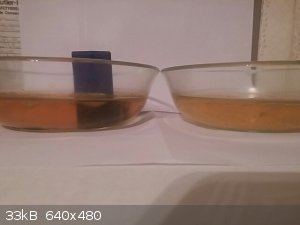 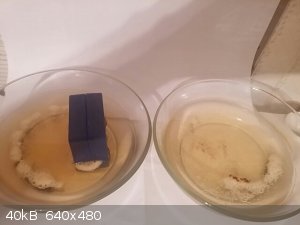
Melgar: I am unclear now as to whether any clumping (due to a magnetic field) has any effect. The driver here, in my assessment, is oxygen kinetics
which may further take advantage of any reduction of hydrogen bonding in the solution due to the magnet field effects.
[Edited on 3-10-2017 by AJKOER]
|
|
|
MrHomeScientist
International Hazard
    
Posts: 1806
Registered: 24-10-2010
Location: Flerovium
Member Is Offline
Mood: No Mood
|
|
Quote: Originally posted by AJKOER  | | Also, other variables are hard to replicate like my iron source, an old cast iron bar. Sea salt itself is a superior electrolyte, but between brands
and their sources of the salt itself, not precise either. Vinegar is not pure acetic acid containing various impurities and likely even variation in
acid strength. I am also using tap water (composition varies from place to place) with added sea salt due to the results claimed for sea water
experiments with magnetic fields. If there was more Fe powder in one bowl than the other, it dissolves very slowly, so relative color and other
observations over time (prior to total dissolving of the iron) is still likely meaningful. |
It's clear you understand the limitations of your setup, and the fact that not taking precise measurements and using impure reagents impacts the
quality of your experiment, and that's great. Yet you take no measures to improve it? It's quite easy and cheap to get pure sodium chloride, acetic
acid, iron, and distilled water. Why you refuse to do so is baffling. Science is all about eliminating variables to ensure the effects you see are
caused by what you're trying to test.
Quote: Originally posted by AJKOER  | | I am noting the results (not precise either) by a visual comparison of solutions and comparing the apparent results to what has been reported in my
cited sources. |
A visual comparison between your two dishes is interesting, but ultimately you cannot draw meaningful conclusions based on that alone. I haven't read
your citations, but I feel certain their papers didn't just say "it got darker."
Quote: Originally posted by AJKOER  | | Designing the experiment to possibly highlight differences in chemical reactions due to magnetic fields takes some thought. |
I thought that was the entire point of your experiment? I'd have thought you would have done some of that thought yourself.
| Quote: | | Melgar: I am unclear now as to whether any clumping (due to a magnetic field) has any effect. |
Because if the iron filings are all stuck together, there is less surface area exposed to the solution to react with it. Available surface area is
hugely important for reaction rates.
|
|
|
AJKOER
Radically Dubious
    
Posts: 3026
Registered: 7-5-2011
Member Is Offline
Mood: No Mood
|
|
One of my link papers to the proposed use of commercial magnetizers is for employment in swimming pools. As MrHomeScientist should know, the latter
are in rich in tap water. Another reference paper concerns the impact of changes in the earth magnetic field on oceans. My recipe of tap water and sea
salt seems appropriate to me. Please follow the links and read the references!
You similarly feel the need to call for pure NaCl, pure acetic acid (and not vinegar, rich in organic, great for some heterogeneous real world
chemistry), and pure iron. Sorry, that is not what this experiment is about, more like with ocean water and swimming pools. Follow the provided link
and you would known that.
You appear to not understand some differences between a spontaneous electro-chemical reaction and conventional chemistry. In the case of many metals
present, for example, and assuming the possibility of a spontaneous electro-chemical cell occurring, the electro- chemistry proceeds only between the
most noble and the least noble metal (based on the difference in their anodic index, see http://www.zygology.com/cms/upload_area/pdf/Zyg-Anodic-Index... ) and totally, yes totally, independent of their concentration (not standard
chemistry, but when its concentration is zero, then the next metal on the anodic list is selected).
Also, all this occurs in the present of an electrolyte. Given the generally low speed of the electro-chemical reaction, there is but a small amount
with a good electrolyte required. It is not a stoichiometric equation, you should know that!
You appear to not known that an open cell with exposure to gases like CO2 can fuel the require H+ for the electro-chemical oxidation of iron to rust,
so the actual strength of the vinegar is immaterial in time!
But, you are invited to measure away to experiment as you wish, if it gives you comfort.
Repeat my experiments as you wish, but I would doubt it because your lack of meaningful comments suggests no knowledge in any of the relevant
disciplines.
The actual purpose of my experiment is to formulate hypotheses for further testing ,and as a first attempt, to try to visually confirm some of the
reports presented in the literature.
MrHomeScientist's final comment is a gem:
"Because if the iron filings are all stuck together, there is less surface area exposed to the solution to react with it. Available surface area is
hugely important for reaction rates."
OK, than why is the partially clumped together magnetizer solution showing the stronger coloration in the latest available pictures? Mainly because,
is it possible that you didn't look at the latest pictures, or read as far as my second sentence where I said "My comments are the concentration of
iron salts appears higher in the magnetizer treated mix", or think about what you are saying?
[Edited on 3-10-2017 by AJKOER]
|
|
|
MrHomeScientist
International Hazard
    
Posts: 1806
Registered: 24-10-2010
Location: Flerovium
Member Is Offline
Mood: No Mood
|
|
Let's dial back the hostility a bit shall we? I'm simply pointing out potential problems with your experiment with the aim of helping you design it
better. When starting with an idea, you generally want to test it in as 'clean' an environment as possible to eliminate variables that might affect
your results, before progressing to 'real world' conditions. Hence the suggestion for pure reagents. If you're using cited studies as a starting point
and going right to real world conditions, that's fine too.
With your mention of the anodic index, I assume you are looking at impurities in your iron filings as a source for your electro-chemical reaction
(since you don't mention adding any other metals). A good way to isolate that effect would be to perform one experiment with your iron and one with
known pure iron. If you see a difference between the two solutions, then you could reasonably hypothesize an electrochemical reaction involving
impurities may be taking place.
Quote: Originally posted by AJKOER  | | OK, than[sic] why is the partially clumped together magnetizer solution showing the stronger coloration in the latest available pictures?
|
It's possible that dish indeed has a higher concentration of dissolved iron, certainly. It's also possible that having the magnetizer resting in the
solution corroded it slightly and contributed to the effect (iron ions are strongly colored, so a tiny bit can make a large difference). Hence my
suggestion to set the dish on top of the magnetizer instead. I'm not saying one possibility is more likely than another, I'm just trying to eliminate
potential sources of error.
Quote: Originally posted by AJKOER  | | Mainly because, is it possible that you didn't look at the latest pictures, or read as far as my second sentence where I said "My comments are the
concentration of iron salts appears higher in the magnetizer treated mix", or think about what you are saying? |
I did indeed read your latest post and see the pictures. It's interesting to be sure, just difficult to draw solid conclusions based on visual
evidence alone. It "appears" higher, sure, but you won't know for certain (or to what degree) until you measure it.
Quote: Originally posted by AJKOER  | | The actual purpose of my experiment is to formulate hypotheses for further testing ,and as a first attempt, to try to visually confirm some of the
reports presented in the literature. |
That's a perfectly valid approach, thank you for elaborating. If your experiments help you form hypotheses that might lead to more experiments, then
they were a success.
|
|
|
Melgar
Anti-Spam Agent
    
Posts: 2004
Registered: 23-2-2010
Location: Connecticut
Member Is Offline
Mood: Estrified
|
|
| Quote: | | OK, than why is the partially clumped together magnetizer solution showing the stronger coloration in the latest available pictures?
|
The reaction would still eventually occur, but it would be slower if there was less surface area. However, the filings might shift around as their
surface eroded and ceased being ferromagnetic. This slight motion might be enough to eventually allow the reaction to proceed further than it might
have otherwise.
If you're trying to test a hypothesis here, would that hypothesis be testable if you used a substrate that wasn't ferromagnetic?
The first step in the process of learning something is admitting that you don't know it already.
I'm givin' the spam shields max power at full warp, but they just dinna have the power! We're gonna have to evacuate to new forum software!
|
|
|
unionised
International Hazard
    
Posts: 5126
Registered: 1-11-2003
Location: UK
Member Is Offline
Mood: No Mood
|
|
I had a look at this
http://onlinelibrary.wiley.com/doi/10.1029/2008GL034288/full
and they claim an effect on viscosity of a magnetic field- as measured by fluorescence polarisation.
But fluorescence polarisation is, itself likely to be affected by the field, even without a solvent
http://www.sciencedirect.com/science/article/pii/00092614878...
and they didn't control for that.
So their "measurement" is unlikely to be real.
Is the rest of their data of the same "quality"?
|
|
|
AJKOER
Radically Dubious
    
Posts: 3026
Registered: 7-5-2011
Member Is Offline
Mood: No Mood
|
|
Unionised:
Interestingly, my reference during the early part of the experiment of a viscosity difference (I stated "It appears that the Magnetizer solution has a
different viscosity and a taint darker color") was something I thought I saw (it really looks like I was running two distinct experiments) and I have
actually forgot the paper reference to the this effect (referring to "Magnetic effect on CO2 solubility in seawater: A possible link between
geomagnetic field variations and climate" by Alexander Pazur and Michael Winklhofer, at http://onlinelibrary.wiley.com/doi/10.1029/2008GL034288/full ).
That paper, on more careful reading, also does states:
"and we may conclude that MF strength affects the equilibrium concentration of dissolved gas in the liquid phase. It is therefore conceivable that
geomagnetic field strength may act as an additional factor that modulates the air-sea exchange of gas."
While I accept the possible change in dissolution rate of O2 (via apparent observations of increased kinetic motion in the oxygen molecules linked to
their apparent paramagnetic nature), some sources are skeptical on claims of alteration of the equilibrium concentration with respect to dissolved
oxygen by itself (that is, when not mixed with CO2).
[Edited on 4-10-2017 by AJKOER]
|
|
|
AJKOER
Radically Dubious
    
Posts: 3026
Registered: 7-5-2011
Member Is Offline
Mood: No Mood
|
|
New pictures!
Concentration appears to have increased in both solutions and more discernibly in the control solution, but not yet entirely caught up to the
magnetizer treated solution.
What is striking, to me, is the relative degree of N2/O2 bubbles related frothing (in height and area) occurring in the magnetic field scenario.
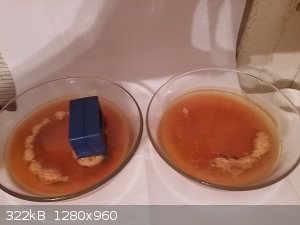
[Edited on 4-10-2017 by AJKOER]
|
|
|
AJKOER
Radically Dubious
    
Posts: 3026
Registered: 7-5-2011
Member Is Offline
Mood: No Mood
|
|
A side view to the above:
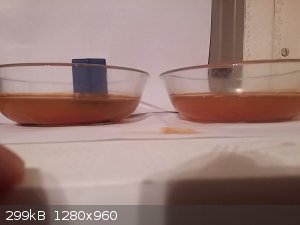
|
|
|
AJKOER
Radically Dubious
    
Posts: 3026
Registered: 7-5-2011
Member Is Offline
Mood: No Mood
|
|
I am not much of an expert on the impact of electrode surface areas on reaction rate. One source to quote:
"Another important factor in galvanic corrosion is the area effect or the ratio of cathodic to anodic area. The larger the cathode compared with the
anode, the more oxygen reduction, or other cathodic reaction, can occur and, hence, the greater the galvanic current....The galvanic Table indicates
that iron is anodic with respect to copper and therefore is more rapidly corroded when placed in contact with it. This effect is greatly accelerated
if the area of the iron is small in comparison to the area of the copper, as shown below"
Link: http://corrosion-doctors.org/Corrosion-Forms/area-effects.ht...
Another study, "Cathode Performance as a Factor in Electricity Generation in Microbial Fuel Cells by Sangeun Oh, et al, Link: https://www.engr.psu.edu/ce/enve/logan/publications/2004-Ohe... .
The results of that particular study to quote:
"Power generation using the Pt-carbon cathode and dissolved oxygen (saturated) reached a maximum of 0.097 mW within 120 h after inoculation
(wastewater sludge and 20 mM acetate) when the cathode was equal size to the anode (2.5 × 4.5 cm)."
Another reference (link: http://miamisprings-shs.enschool.org/ourpages/auto/2017/6/13...) makes a comment to quote:
".., the small particle [referring to iron] has a relatively large surface area for reaction; perhaps 1 to 10 square meters per gram. "
So assuming I employed at least 2 gram of Fe, the surface area would perhaps be in the neighbor at least 2 sq meter. If even half was buried in a
cluster (not likely per by the froth area visible on the solution), the surface area of the iron (anode) is way in excess of the bowl's interface with
air (the cathode, where the bowl has a diameter under 15 cm).
In short, amend my calculations based on further research, but it appears to me based albeit on my current limited research that Fe clustering should
not be a competitive factor in comparative reaction rates between the magnetizer treated and the control solution.
[Edited on 4-10-2017 by AJKOER]
|
|
|
Melgar
Anti-Spam Agent
    
Posts: 2004
Registered: 23-2-2010
Location: Connecticut
Member Is Offline
Mood: Estrified
|
|
The bubbles are probably hydrogen. Salt will catalyze the oxidation of iron metal to iron ii hydroxide, which clearly has a different ratio of
hydrogen atoms to oxygen atoms as water does. So those missing hydrogen atoms were reduced to elemental hydrogen.
The first step in the process of learning something is admitting that you don't know it already.
I'm givin' the spam shields max power at full warp, but they just dinna have the power! We're gonna have to evacuate to new forum software!
|
|
|
AJKOER
Radically Dubious
    
Posts: 3026
Registered: 7-5-2011
Member Is Offline
Mood: No Mood
|
|
Melgar:
Thanks for that comment. Here is an extract from Wikipedia (https://en.wikipedia.org/wiki/Schikorr_reaction ):
"The Schikorr reaction can occur in the process of anaerobic corrosion of iron and carbon steel in various conditions.
Anaerobic corrosion of metallic iron to give iron(II) hydroxide and hydrogen:
3 (Fe + 2 H2O → Fe(OH)2 + H2)
followed by the Schikorr reaction:
3 Fe(OH)2 → Fe3O4 + 2 H2O + H2 "
OK, assume little O2 actually enters the solution and/or it is otherwise consumed as there is no agitation. Then, per local anaerobic conditions,
hydrogen would be generated!
------------------------------------------------------------------
I will think about how either H2 producing reaction could be accelerated in the presence of a magnetic field.
-----------------------------------------------------
[EDIT] My take, first to quote the same Wiki page:
"The global reaction can thus be decomposed in half redox reactions as follows:
2 (Fe2+ → Fe3+ + e−) (oxidation of 2 iron(II) ions)
2 (H2O + e− → ½ H2 + OH−) (reduction of 2 water protons) "
The last reaction, as I recall, is slow and given the cited ability of magnet fields to promote proton reactions, it is accelerated resulting in more
hydrogen bubbling.
My reference on the last point, to quote:
"Magnetic fields can also increase proton spin relaxation [623], which may speed up some reactions dependent on proton transfer. Treatment of water
with magnetic fields of about one Tesla increases the strength of mortar due to its greater hydration [426]. "
Source: link: http://www1.lsbu.ac.uk/water/magnetic_electric_effects.html#...
In a sense, Fe + 2 H2O → Fe(OH)2 + H2, is a iron hydration reaction releasing hydrogen gas.
[Edited on 4-10-2017 by AJKOER]
[Edited on 4-10-2017 by AJKOER]
|
|
|
Sulaiman
International Hazard
    
Posts: 3696
Registered: 8-2-2015
Location: 3rd rock from the sun
Member Is Offline
|
|
When I was experimenting with reducing sugars, methylene blue, Thunberg tubes etc. I noticed that
atmospheric oxygen can rapidly diffuse into a very thin layer on top of a water based solution so quickly that it can keep methylene blue, blue, even
with a fairly concentrated sugar solution.
Your solutions have a large area exposed to the atmosphere relative to volume, so I wouldn't discount atmospheric gasses.
I have 10 petri dishes in the post and a good collection of magnets, so I hope to join in soon.
(but first I want to re-visit growing tin crystals by electrolysis https://www.youtube.com/watch?v=G1sq4hnrBgM&t=1s but this time with a fairly strong magnetic field. (20mm dia x20mm N54 magnets))
CAUTION : Hobby Chemist, not Professional or even Amateur
|
|
|
AJKOER
Radically Dubious
    
Posts: 3026
Registered: 7-5-2011
Member Is Offline
Mood: No Mood
|
|
Sulaiman:
Interesting comment.
I do not want to add more confusion to your experiment planning, but here are a few points to consider and verify:
> First, my experiment is with a magnetizer, which is not just a magnet, but an ordered collection of strong and weak fields to leave a residual
magnet footprint when a metal object is inserted (or a fluid passes) through the tunnel. See, for example, http://www.hsmagnets.com/blog/tool-magnetizer-demagnetizer-w... . I can across the mention of this device (but commercial strength) in a online
proposal to reduce chemical costs associated with public pools in England, so there is an apparent impact on pool chemistry.
> Reaction can apparently be impacted by both weak and strong magnetic fields. There are cost and potential dangers differences as well.
> There are variations in type of magnet field with possibly differing results, namely static electric fields versus alternating electric fields.
> Some even report experiments using both types. If I recall correctly, this mixed approach appears to very disagreeable to microorganisms, a
disinfecting protocol. Caution, this may apply adversely to people (and especially children) also.
> I have not researched the effect of strong magnetic fields on humans, but if you are going to experiment with such fields, known the risk. I wish
a biochemist would comment, even on speculated possible biochemical effects, on living organisms short and long term.
[Edited on 5-10-2017 by AJKOER]
|
|
|
Melgar
Anti-Spam Agent
    
Posts: 2004
Registered: 23-2-2010
Location: Connecticut
Member Is Offline
Mood: Estrified
|
|
Yeah, you probably shouldn't assume that the interaction of atmospheric oxygen is insignificant. If you've ever dissolved iron in sulfuric acid under
anaerobic conditions, you've probably gotten the typical pale blue iron ii salt. Even a slight exposure of this solution to oxygen though, will
immediately form yellow-brown iron iii salts on the surface. It's a good bet that you have iron iii oxide-hydroxide if your reaction color is brown
and not blue.
edit: https://en.wikipedia.org/wiki/Iron(III)_oxide-hydroxide
[Edited on 10/5/17 by Melgar]
The first step in the process of learning something is admitting that you don't know it already.
I'm givin' the spam shields max power at full warp, but they just dinna have the power! We're gonna have to evacuate to new forum software!
|
|
|
AJKOER
Radically Dubious
    
Posts: 3026
Registered: 7-5-2011
Member Is Offline
Mood: No Mood
|
|
Last run pictures for Experiment 2:
The solution are pretty much the same except today the control solution has a little more height to the froth, which is apparently centered around a
piece of iron.
The observation that the Fe metal is floating does seemingly support that, at least to some extent, the reaction:
Fe + 2 H2O → Fe(OH)2 + H2(g)
is occurring.
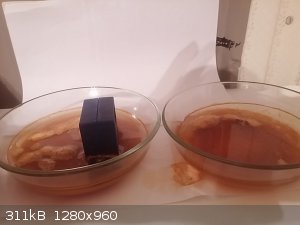
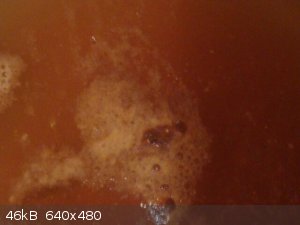
[Edited on 5-10-2017 by AJKOER]
|
|
|
AJKOER
Radically Dubious
    
Posts: 3026
Registered: 7-5-2011
Member Is Offline
Mood: No Mood
|
|
I nearly drained the solutions and added water in order to examine the sediment. The picture below is from the sediment in the control solution
showing no more iron, except for a few larger ensembles, one of which was captured above:
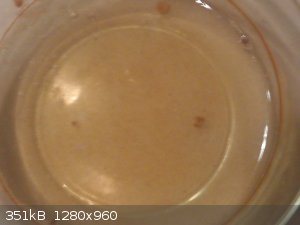
[Edited on 5-10-2017 by AJKOER]
|
|
|
AJKOER
Radically Dubious
    
Posts: 3026
Registered: 7-5-2011
Member Is Offline
Mood: No Mood
|
|
The magnetizer treated sediment was basically nill.
One might hypothesize that the magnetizer treated solution represents around a day of acceleration over the control, or approximately 20%.
This is however nearly insignificant as compared to some reported results in select electrolysis experiments. See Zou, P.; Leddy, J., 'Magnetized
Nickel Electrodes for Improved Charge and Discharge Rates in Nickel Metal Hydride and Nickel Cadmium Batteries', Electrochemical and Solid-State
Letters 2006, 9, A43-A45. To quote:
"magnetized electrodes yielded higher currents than the corresponding nonmagnetic electrodes by 70 and 230 %, respectively."
Link: https://www.electrochem.org/dl/ma/206/pdfs/0541.pdf
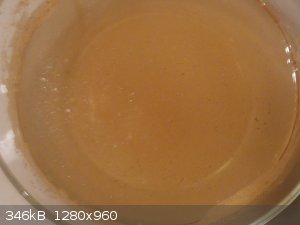
[Edited on 5-10-2017 by AJKOER]
|
|
|
AJKOER
Radically Dubious
    
Posts: 3026
Registered: 7-5-2011
Member Is Offline
Mood: No Mood
|
|
Those thinking of replacing the iron filings with something more energetic in a related experiment may find the following reference interesting, which
I can across today:
"An insight in magnetic field enhanced zero-valent iron/H2O2 Fenton-like systems: Critical role and evolution of the pristine iron oxides layer", by
Wei Xiang, Beiping Zhang, Tao Zhou, Xiaohui Wu & Juan Mao, available at https://www.nature.com/articles/srep24094 .
|
|
|
|